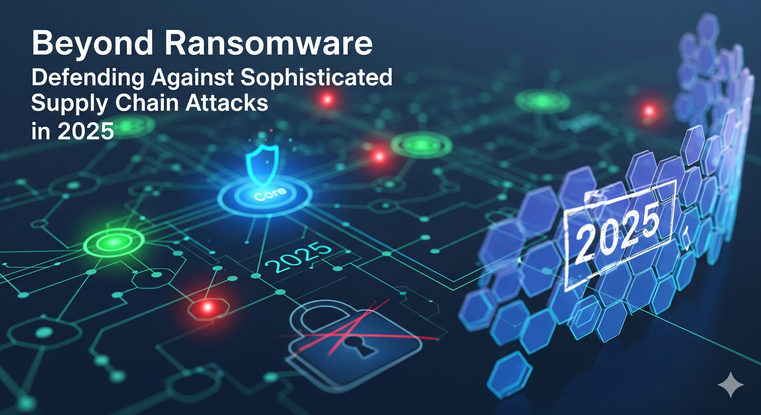
Beyond Ransomware: Defending Against Sophisticated Supply Chain Attacks in 2025.
Introduction
Cybersecurity in 2025 has moved far beyond defending against traditional ransomware. While ransomware remains a threat, supply chain attacks have emerged as one of the most sophisticated and damaging forms of cybercrime. These attacks exploit vulnerabilities in trusted third-party software, vendors, or services, allowing attackers to infiltrate multiple organizations simultaneously.
The rise of remote work, globalization, cloud adoption, and AI-driven automation has made the digital supply chain more complex, interconnected, and vulnerable than ever before. Businesses that once only worried about direct threats must now defend against hidden risks buried deep within their ecosystem.
In this blog, we’ll break down:
-
What supply chain attacks are
-
Why they’re more dangerous than ransomware
-
Real-world examples from recent years
-
Emerging trends in 2025
-
Best practices and defense strategies to safeguard your organization
If you’re serious about cybersecurity in today’s environment, this guide will help you move from being reactive to proactive.
What are Supply Chain Attacks?
A supply chain attack occurs when cybercriminals compromise a third-party vendor, service provider, or software that an organization relies on, in order to gain access to its systems. Unlike ransomware, which usually targets a single entity, supply chain attacks can cascade across multiple companies simultaneously.
How They Work:
-
Targeting Vendors: Hackers exploit vulnerabilities in software updates, cloud services, or hardware components.
-
Backdoor Injection: Malicious code is secretly inserted into trusted software.
-
Mass Exploitation: Once distributed, this backdoor grants access to multiple organizations that use the compromised product.
-
Data Theft & Espionage: Attackers can steal sensitive data, deploy further malware, or conduct espionage undetected.
Why Supply Chain Attacks are More Dangerous than Ransomware
While ransomware locks files for ransom, supply chain attacks silently infiltrate trusted systems, making them harder to detect and far-reaching in scale.
Key reasons these attacks are more threatening in 2025:
-
Scale of Impact: A single breach can affect thousands of organizations globally.
-
Delayed Detection: Malicious code often hides within legitimate updates, going unnoticed for months.
-
Trust Exploitation: They exploit trusted relationships with vendors and partners.
-
National Security Risks: Nation-states increasingly use supply chain attacks for espionage.
Real-World Supply Chain Attacks
-
SolarWinds Attack (2020): A malicious code was injected into Orion software updates, affecting government agencies and Fortune 500 companies worldwide.
-
Kaseya VSA Attack (2021): Hackers compromised IT management software, impacting thousands of downstream businesses.
-
Log4j Vulnerability (2021): A small flaw in a widely used open-source library exposed countless systems globally.
By 2025, such attacks have grown even more AI-enhanced, stealthy, and automated, making them harder to prevent with traditional security methods.
Supply Chain Attack Trends in 2025
1. AI-Powered Attacks
Cybercriminals are leveraging Generative AI models to automate phishing campaigns, create polymorphic malware, and identify vulnerabilities faster than ever.
2. Cloud Service Exploitation
As more businesses migrate to cloud providers, attackers target shared cloud environments and misconfigured SaaS integrations.
3. Zero-Day Exploits in Open Source
Open-source libraries are widely adopted, but attackers are embedding malicious code into popular repositories, knowing businesses trust and integrate them blindly.
4. Deepfake-Based Social Engineering
Hackers now use deepfake audio and video to impersonate executives, tricking employees into approving malicious integrations or vendor changes.
5. Nation-State Driven Supply Chain Espionage
State-sponsored cyber groups exploit digital supply chains not just for financial gain, but for political, economic, and military advantage.
Best Defense Strategies Against Supply Chain Attacks
1. Vendor Risk Management
-
Conduct regular third-party risk assessments.
-
Limit access to sensitive data for vendors.
-
Demand transparency in security practices from partners.
2. Zero Trust Architecture
-
Adopt a “never trust, always verify” approach.
-
Enforce multi-factor authentication (MFA).
-
Monitor network activity continuously.
3. Software Bill of Materials (SBOM)
-
Track and verify all components used in your software.
-
Quickly identify vulnerabilities in open-source or third-party code.
4. Threat Intelligence & Monitoring
-
Leverage AI-powered threat intelligence platforms.
-
Monitor for anomalies across endpoints, networks, and cloud environments.
5. Employee Cybersecurity Training
-
Educate teams to spot phishing attempts, malicious updates, and impersonation attacks.
-
Run regular red team vs. blue team exercises.
6. Incident Response Planning
-
Prepare a playbook for supply chain attack response.
-
Regularly test backup and recovery strategies.
👉 Explore Our Course: Cybersecurity Training for Professionals
Why Businesses Must Act Now
In 2025, cybersecurity is no longer an IT issue—it’s a business resilience issue. Customers, regulators, and stakeholders expect organizations to secure their digital supply chains. Companies that fail to adapt risk not only financial losses but also brand trust and compliance penalties.
By investing in advanced defenses, businesses can stay ahead of attackers instead of reacting to them.
Conclusion
Ransomware may have dominated headlines in the past, but supply chain attacks represent the future of cybercrime. With AI-powered tactics, stealth infiltration, and global-scale risks, defending against them requires a multi-layered approach.
From adopting zero trust architecture to implementing vendor risk management and employee awareness programs, businesses must prioritize supply chain security in 2025.
Cybersecurity isn’t just about protecting data—it’s about protecting your entire ecosystem. And in today’s interconnected world, that ecosystem extends far beyond your walls.






